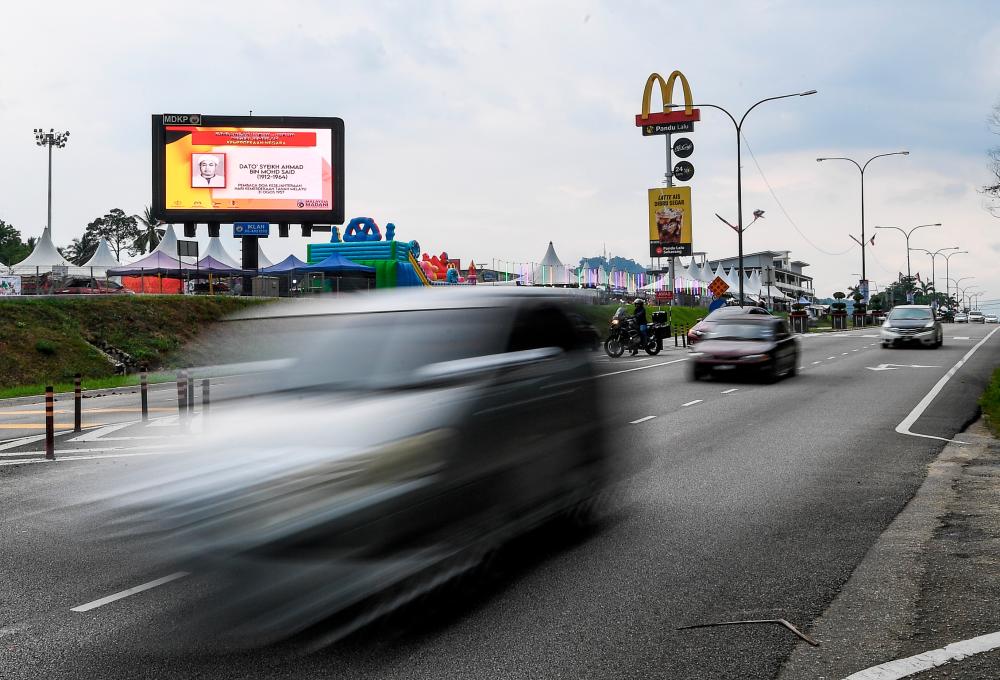PETALING JAYA: The Malaysian Institute of Road Safety Research (Miros) has urged outdoor advertisers to adhere to regulatory guidelines for electronic billboards, as failure to do so could pose a danger to motorists.
Its chairman Prof Dr Wong Shaw Voon said while the main goal of advertising is to attract as much attention as possible, electronic billboards often override concerns about the safety of motorists.
“While safety issues should be addressed, the designers of these advertisements might not prioritise them, as their primary aim is to capture the attention of as many motorists as possible.”
He said electronic billboards should have adaptive brightness features to ensure they do not distract and endanger the safety of road users.
Wong was commenting on public concerns over electronic billboards in the Klang Valley, which are too bright, distracting, and pose safety risks to motorists.
The complaints involve those on the Federal Highway near Bangsar, Damansara-Puchong Highway (LDP) in Kelana Jaya, and the Sprint Highway, among others.
Wong said advertisements and electronic equipment must adhere to brightness standards set by the UK Institution of Lighting Engineers or Miros guidelines.
“In areas with street lighting, the maximum brightness is 1,200 cd/m² during the day and 300 cd/m² at night for advertisement areas of 2.0 m² to 5.0 m². Cd/m² is ‘candela steradian’ per square metre and defined as a unit of illuminance and luminous emittance.
“In areas without street lighting, the maximum brightness is 600 cd/m² during the day and 150 cd/m² at night for the same area size,” he said.
Paul Tan’s Automotive News reported that along the LDP in Kelana Jaya, an extremely high brightness level of 277 cd/m² was recorded.
“Brightness readings were 170 cd/m² at Bangsar Village and 207 cd/m² at Jalan Maarof. The brightness varied significantly depending on the advertisement, with those featuring white backgrounds being the brightest.
“At the Sprint Highway Section 17 intersection, the maximum recorded brightness was 184 cd/m². Although this was within regulation limits, the brightness was intense enough to disrupt driving.”
Wong said using electronic billboards can be distracting even if it only diverts 1% of a motorist’s attention, which is still dangerous.
“When driving, we often rely on our subconscious mind to navigate the roads and are not fully conscious of every action we take. This subconscious driving can be disrupted by unexpected stimuli, which causes surprise or panic.
“The brightness of electronic billboards often stays the same throughout the day and night, leading to problems. During the day, the brightness might be acceptable, but at night, it remains at a high level that can cause eye discomfort and strain.”
Wong also said the size of advertising billboards generally varies depending on their location.
Wide junctions with frequent traffic jams require different standards compared with smaller areas. Banners might be suitable for lower-speed areas, while billboards are better suited for higher-speed zones.
“For electronic displays, safety and maintenance should also be considered.”
Wong said in Malaysia, outdoor billboard advertising is governed by the Local Government Act 1976 and the Street, Drainage and Building Act 1974, along with relevant by-laws and regulations in the district council.
theSun repeatedly reached out to the Petaling Jaya City Council and the Outdoor Advertising Association of Malaysia for comments over two weeks, but they have not responded.









